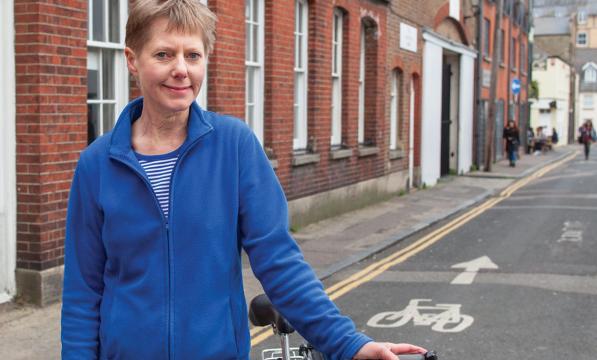We make Space for Cycling

CTC’s power comes from its networks of volunteers: thousands of ride leaders and campaigners who work to get more people into cycling and who lobby councils across the country. It is thanks to their work that the new cycle route that appeared in your town was built or, sadly more likely, that the worst designs for new roads were sent back to the drawing board – or amended to make them a bit better.
To back up those CTC volunteers in their dealings with councillors and officers, we need to show that there are many more people who want improved conditions for cycling. That’s what Space for Cycling is about. Thousands of people have already written to their councillors. If you haven’t yet, visit space4cycling.org.uk to find out how you can get involved.
CTC’s Space for Cycling campaign is run in coordination with Cyclenation local campaign groups and funded by the Bike Hub, the cycle industry funded levy. It follows the London Cycling Campaign’s lead; there the local elections have provided an opportunity to focus candidates’ attention on cycling. Outside London, the local elections aren’t as crucial, but sitting councillors still control vast – if diminishing – budgets, and they decide what happens on the streets and roads that we use every day.
These are just a couple of the stories of CTC campaigners out there working to make Space for Cycling, either with the help of, or in the teeth of opposition from, their local council.
Becky Reynolds, Brighton
In 1998, Brighton and Hove decided that many of their roads needed to become one-way to stop them from being used as rat-runs by motorists. On the surface, this makes complete sense: no one wants their road to become the go-to route for fast-moving cars or taxis. The downside of the new one-way systems was that no provision for cyclists was made alongside. So cyclists faced the choice of going far out of their way or riding illegally, which many did.
‘Having cycled from childhood, it began to make me angry when I saw rules and roads changed that made it unnecessarily difficult for cyclists,’ says Becky. ‘I guess I’m an enthusiast for improved conditions. I don’t want to live in a place where children are strapped into cars from the moment they’re born.’
One of the main affected areas of the city was Brighton’s North Laine, a network of shopping and residential streets near Brighton railway station. Recent studies have shown that shoppers who arrive by bicycle can provide an essential boost to local economies and can help regeneration, something people rarely considered in the 1990s.
Becky and her fellow campaigners at Bricycles began a cleverly-named ‘One way? No way’ campaign, insisting that there should be no one-way streets without a two-way provision for cyclists. One of her fellow campaigners was a cycle trainer, Ian Davey, who went on to become one of Brighton’s Green Party councillors.
Things really began to change once the Greens took control of the council and formed a minority administration in 2011. ‘There are a lot of environmentally-minded people in Brighton,’ says Becky, ‘but we really gained momentum when Ian Davey joined the Green Party. It created a sea of change in the community, and a lot positive changes gained cross-party support.’
In the autumn of 2012, Becky Reynolds, Bricycles, Councillor Ian Davey and fellow campaigners were able to celebrate their success as Brighton’s North Laine was transformed: many one-way streets became two-way for cycling.
Sarah Sharp, Chichester
‘It was my daughter that was really the driving force,’ Sarah admits. A shy and quiet girl, she took a lot longer than her brother to learn to ride. But at the age of 11, and after the first two days of cycling to school with mum, Sarah’s daughter expressed a desire to go on her own.
Like any mother, Sarah didn’t want to stifle her daughter’s independence but she also needed to ensure her safety. The school had two drop-off points: one for cars and one for bicycles. But with most parents driving their teenagers to school, there was often a pinch point, and some confusion, especially when not everyone went the same way.
‘I saw parents I knew, even ones with teenage sons older than my daughter, driving their kids to school. I realised they drove because of fear,’ Sarah says. ‘They simply didn’t feel it was safe for their kids to cycle.’
That’s when Sarah started thinking she should do something. Realising what that was didn’t come until February 2010, when she held a meeting over her concerns and a member mentioned Portsmouth’s successful 20’s Plenty campaign. Hearing about how Portsmouth was able to make its roads safer got her thinking, and she asked: ‘What are the obstacles to creating a 20mph campaign for Chichester?’
While it was Portsmouth’s campaign that gave her direction and started her on the path to success in 2013, it was not always easy. In November 2012, Chichester Council decided to leave the decision of whether to adopt the 20’s Plenty campaign to a public vote. The decision outraged Sarah, for whom the campaign was always about protecting the city’s children first and foremost.
‘There was a lot of work but there was a lot of fun too,’ Sarah says. ‘On “In town without my car day”, we took over a prime parking space in a very busy car park, rolled out grass, set up lawn chairs, and brought out lots of cakes. It was a beautiful day and we collected 200 signatures in favour of the campaign.’
Knowing that she was doing something to benefit the entire community, Sarah relied heavily on fellow volunteers. She received help and encouragement from the original 20’s Plenty for Us campaigns team.
This was first published in the June / July 2014 edition of CTC's Cycle magazine.

